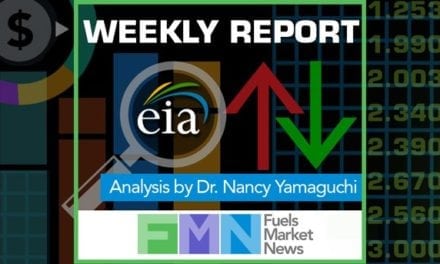Oil Markets Coming About
1. Crude oil inventories reach record highs
2. Crude oil prices break resistance
3. Crude oil price curve flattens
4. Crude oil price objective somewhere north of $40
5. Natural gas supplies finishing withdrawal year near record highs
Table covers crude oil and principal products. Other products, including residual fuel oil and “other oils” are not shown, and changes in the stocks of these products are reflected in “Total Petroleum Products.”
Statistics Source: Energy Information Administration “Weekly Petroleum Status Report” available at www.eia.doe.gov
The Matrix
U.S. crude oil supplies continue to reach new highs, topping 695 million barrels in the latest Energy Information Administration weekly balance sheet. Nonetheless, WTI futures defy gravity and move higher. Prices bottomed on February 11; WTI fell to $26.05. Since then, crude oil added nearly $12.50 to value, the price increasing by half.
Oil markets are in contango – the price of the spot futures contract is lower than more distant prices, an indication of surplus stocks. Ordinarily, as supplies dwindle the price curve flattens. And that has happened in crude oil markets. Contango has narrowed as compared with early 2015 but has not been replaced with backwardation. The contradiction of growing inventories and rising prices focuses on an important concern for traders.
The chart shows the differences for both Brent and WTI prices between the nearby month and the price in the seventh month since January 2014. These differences have narrowed, but prices remain in carry (another word for contango.)
A contango market is bearish, but the tightening is clear and confusing in light of the continuing growth of inventory.
It takes time and miles of ocean to turn a large ship. There are few ships larger than the global energy market. Reports of diminishing production in the United States are only now starting to appear in official reports – and only if you look for them. Only now are OPEC producers signaling that they’ve absorbed enough financial pain to talk about freezing output. Even at currently high levels, this must be a precursor to actual cuts in production. And tepid demand responses to low prices (outside the United States) cannot help the case for price bulls.
Inventories rise but contango stalls. The global oil market may be turning, but it still requires time and space to complete the task. In the short run, market action reflects OPEC’s first efforts to slow production suggesting that new lows may not be seen this year. Rallies present their own challenge with resistance for WTI put somewhere above forty dollars.
Supply/Demand Balances
Supply/demand data in the United States for the week ending March 4, 2016 were released by the Energy Information Administration.
Total commercial stocks of petroleum decreased 0.7 million net barrels during the week ending March 4, 2016.
Builds was reported in stocks of fuel ethanol, K-jet fuel, and other oils. Draws were reported in stocks of gasoline, distillates, residual fuel oil, and propane.
Crude oil supplies in the United States increased to 521.9 million barrels, a build of 3.9 million barrels. This is a new record for U.S. commercial crude oil storage, government data show.
Crude oil supplies increased in four of the five PAD Districts. PADD 2 (Midwest) crude oil stocks increased 0.8 million barrels, PADD 3 (Gulf Coast) crude oil stocks expanded 2.5 million barrels, PADD 4 (Rockies) grew 0.3 million barrels, and PADD 5 (West Coast) stock increased 1.0 million barrels. Crude oil stocks in PAD District 1 (East Coast) decreased 0.5 million barrels.
Cushing, Oklahoma inventories increased 0.6 million barrels to 66.9 million barrels.
Domestic crude oil production increased 1,000 barrels daily to 9.078 million barrels per day.
Crude oil imports averaged 8.048 million barrels per day, a daily decrease of 244,000 barrels.
Refineries used 89.1 per cent of capacity, an increase of 0.8 percentage points from the previous report week.
Crude oil inputs to refineries increased 59,000 barrels daily; there were 15.911 million barrels per day of crude oil run to facilities. Gross inputs, which include blending stocks, increased 155,000 barrels to 16,192 million barrels daily.
Total petroleum product inventories saw a decrease of 4.6 million barrels from the previous report week.
Gasoline stocks decreased 4.5 million barrels; total stocks are 250.5 million barrels. Demand for gasoline increased 290,000 barrels per day to 9.411 million barrels daily.
Total product demand increased 665,000 barrels daily to 19.864 million barrels per day.
Distillate fuel oil supply decreased 1.1 million barrels; total stocks are 162.5 million barrels. National distillate demand was reported at 3.706 million barrels per day during the report week. This was a weekly increase of 342,000 barrels daily.
Propane stocks decreased 0.7 million barrels to 62.3 million barrels. Current demand is estimated at 1.241 million barrels per day, a decrease of 372,000 barrels daily from the previous report week. Propane prices are starting to move. Nearby propane futures, both at Mt. Belvieu and Conway Kansas are priced above more distant months. The spread is growing. This is a bullish indicator.
Natural Gas
According to the EIA:
Net withdrawals are significantly below the five-year average and last year’s withdrawals. Net withdrawals from storage totaled 57 Bcf, compared with the five-year average of 118 Bcf, and last year’s pull of 174 Bcf.
Working gas stocks could finish the heating season near record-high levels. If withdrawals from storage follow the five-year average for the remainder of the heating season, working gas stocks will total 2,336 Bcf on March 31–the traditional end of the heating season. The record high for stock levels at the end of the heating season occurred in 2012, when working gas stocks totaled 2,473 Bcf on March 31, 2012, following a much warmer-than-normal winter. Working gas stocks are 727 Bcf above the five-year average and 911 Bcf above last year at this time.
The natural gas rotary rig count fell below 100 this week, with 97 active units in service as of March 4, 2016. This is the lowest level in Baker Hughes’s recorded history. The total rig count fell by 13 units to 489, with oil rigs falling by 8 units to 392.
Futures trading involves significant risk and is not suitable for everyone. Transactions in securities futures, commodity and index futures and options on future markets carry a high degree of risk. The amount of initial margin is small relative to the value of the futures contract, meaning that transactions are heavily “leveraged”. A relatively small market movement will have a proportionately larger impact on the funds you have deposited or will have to deposit: this may work against you as well as for you. You may sustain a total loss of initial margin funds and any additional funds deposited with the clearing firm to maintain your position. If the market moves against your position or margin levels are increased, you may be called upon to pay substantial additional funds on short notice to maintain your position. If you fail to comply with a request for additional funds within the time prescribed, your position may be liquidated at a loss and you will be liable for any resulting deficit. Past performance may not be indicative of future results. This is not an offer to invest in any investment program.
Powerhouse is a registered affiliate of Coquest, Inc.
We’d like your feedback.
Please respond to [email protected]
or call: 202 333-5380
Copyright © 2016 Powerhouse, All rights reserved.













